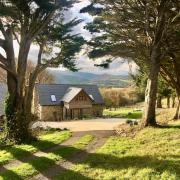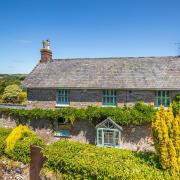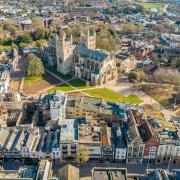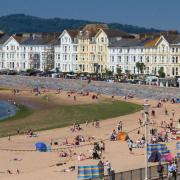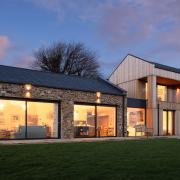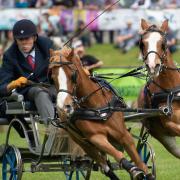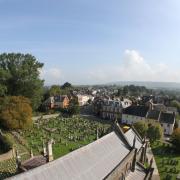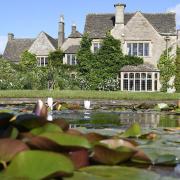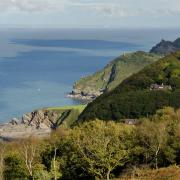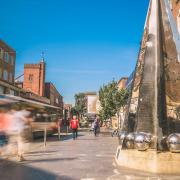Thousands of photos are taken on the moor but few capture the spirit of the land and its people like Chris Chapman’s black and white images

In 1974 Chris Chapman traipsed the length and breadth of Dartmoor with camera in one hand and leading Mistletoe, the donkey, with the other. There began a love affair with the moor (although not the donkey!) that never left.
Chris still lives on the moor and still shoots the same breathtaking images of the landscape, its people and its practices.
He grew up on the Pennines and spent many happy childhood hours walking over the moors or visiting his uncle’s farm. “Dartmoor felt like coming home,” he says.

Chris is one of those rare photographers who manages to capture the essence of his subject. This is not surprising as he comes with a strong photographic pedigree.
As a student at Newport Art College in the 1970s his work caught the attention of Magnum photographer, David Hurn, who was setting up a documentary photography course. Chris was invited to join.
“I loved every minute,” Chris enthuses. “He is possibly the most influential person in photographic education in this country and he taught me the importance of recording what I saw as honestly as I could.”

Chris’s 1974 Dartmoor journey set out to capture the hill farming community in a way that had never been done before.
“The culture of the 1970s, with its small farms, had changed very little over time. I love the layered landscape of generations and wanted to capture not simply the beauty of the landscape, but the life and soul of the moorland communities.”
By immersing himself into their lives, Chris shot images that had a quality beyond the obvious.

“I did not intend to stay more than a few months,” he explained. “But I was offered a wonderful studio – a tithe barn near Chagford. My work by this time had begun to take off – there was never an incentive to leave.”
Chris is the first to admit that living on Dartmoor is not easy. “Fine to visit, but you have to be tough to live and work on the moor,” he explains. “However, amidst this I found from the start that there was a generosity of spirit amongst the local population. In my first few years I do not think I would have survived without the wonderful meals from the Hutchings family at Postbridge and the Brays at Bellever.
“My first winter was particularly vicious and they kept me going in health and spirit,” recalls Chris. “I have always found the tradition of farming attractive to the camera,“ he says, adding, “I feel at home and that is when the subjects seems to ‘sing’.”

In return he is accepted and not even noticed when he disappears behind the lens:
“Growing up around the Pennines and the culture of the small farm I was not seen as a threat.”
In the 1980s he met Paul and Kay Henderson, owners of Gidleigh Park. They immediately struck up a friendship and commissioned a set of his photographs.
“This was just what my career needed,” he says. “They wanted to capture the essence of the moor in every room. I feel privileged that they chose my work.” Today, many of his images can still be seen on the hotel’s walls.
Black and white photography has always been his preferred format. “I love its timeless quality and it is less distracting to the eye,’ he comments.
For Chris, turning his camera on life appears effortless and natural, but it takes determination to achieve what he has accomplished.
At times this has been hard. During the foot-and-mouth epidemic he was commissioned to record farms across the region. In particular he followed Philip Lake, of Ramscliffe Farm, in Mid Devon, who lost his entire stock of dairy cattle and sheep – not because they had the disease, but because a neighbouring farm did.
A sombre few months, but his sensitive approach revealed moving images of the heartbreak experienced by farmers. “It is something I will never forget,” says Chris.
Other shots have a happier side: “Mary Wedlake at her wedding reception or more recently Ivor Pellow and his missing tooth!”
Chris adds: “In photography we are always learning. That is exciting.”
Chris is out on the moor early each morning – camera in hand, continuing to strive for that perfect shot: “It is part of me – my third eye.”
A life in pictures:
Chris has work held in gallery collections in the UK and abroad including the Victoria & Albert Museum, London; Arts Council England; the International Center of Photography, New York.
His published work includes: The Right Side of the Hedge (David & Charles) 1976; Dartmoor: the Threatened Wilderness (Channel 4); and Wild Goose & Riddon, The Dartmoor Photographs of Chris Chapman (Halsgrove 2000)
Awards include: Photographer of the Year (2005) – Countryman magazine for outstanding photographic work during the foot-and-mouth outbreak; Dartmoor Society Award (2008) for outstanding documentary photography of people.
Work in progress: Chris is currently working on a new book detailing a lifetime in photography: “I have a huge archive that is not just about Dartmoor – ranging from a moving encounter with the late Laurie Lee to an assignment documenting the last of the free miners working in the Forest of Dean. Many of these pictures have never been seen before, so it seems appropriate to set them in book form.”
You can see more of his work on his website .




